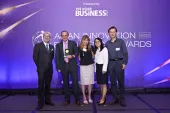
KPMG’s Chris Hardesty shares his insight at Healthcare Asia
For the Director for Healthcare & Life Sciences Practice, there is always something to teach—and learn—in the field of healthcare service.
Chris is a member of KPMG’s Global Healthcare & Life Sciences Centre of Excellence where he holds experience across a variety of markets and project types. Having relocated from the UK to Singapore to focus on developments in the APAC region, he is a regular columnist for Healthcare Asia and has authored several publications about life sciences, healthcare, and health systems for KPMG. Moreover, Chris has taken part in initiatives and projects related to sustainable health financing, mental health, drug serialisation, hospitals, pharmaceutical companies, medical devices, and many others.
As a person whose drive stems from his past experiences while growing up, Chris is passionate about innovative, safe, and economically viable initiatives in the healthcare sector through public-private collaborations. This passion has been his “north star”, one that has guided him to make decisions that make the most impact in the industry.
Healthcare Asia is pleased to sit down with Chris as he gives his unique perspectives about the state of Asia’s healthcare during the pandemic; the need for “frugal innovation”; the importance of continuous educational dialogue between the government and private sectors; “triple aim” to “triple win” perspective changes; creativity and empathy; and more importantly, the traits needed to become a Healthcare Asia winner.
Can you share with us your work experience or a backstory that has contributed to your healthcare expertise?
I suffered major trauma growing up, and still have metal plating in my body to this day. These experiences, including the loss of loved ones from both physical as well as mental disease, have driven my passion to make an impact in healthcare.
I previously worked in the pharmaceutical industry, including being based in South America to design access schemes for vulnerable communities. I have been with KPMG’s Global Healthcare & Life Sciences Centre of Excellence for over ten years, including postings in the US, Europe, and the Asia-Pacific. My role is to construct public-private pathways so as to bring novel medical innovations to market in a safe, efficient, and economically viable way. In addition, I also serve as an adjunct lecturer, writer, and start-up/fund advisor.
When judging the winners, what specific traits or achievements will make a healthcare company stand out from the rest? company stands out from the rest?
I take a “If Disney Ran Your Hospital” frame of mind (excellent book from the 1990s), which is that quality and safety as a baseline must in this industry. From there, I really look for the innovations alongside the people and service delivery axioms, since I believe these can be overlooked criteria that remain important to a well-functioning health system. And finally, as the need of the hour implies, the strategic adoption of new technologies in such a way as to not disrupt the prior elements. Bonus points for those who are clever about the financing too.
What are some of your observations about this year’s nominated entries?
Firstly, I’m very moved by the contributions from across the sectors in dealing with one of the most difficult crises of our lifetime (COVID-19). With these innovations borne out from the situation, I hope that these concepts from many of the submissions will stick around long after the pandemic is resolved. And finally, kudos to Healthcare Asia. It’s exciting to see the submissions from such a variety of nations and subsector pathways. The spirit closely follows KPMG’s motto in healthcare – something to teach, something to learn.
How has the pandemic affected the way you view healthcare, especially in the APAC Region?
As someone who primarily focuses on the intertwine between health and economy, the message very much came to light over the past year: those nations with strong, smartly funded, future-proofed health system design are proving most resilient in the face of the pandemic—akin to the old mantra, “health is wealth”. Moreover, it’s exciting to see so many new potential entrants into the space, ranging from employers to logistics companies to fintech. It is a very difficult period and the fight remains far from over, but the level of innovation and collaboration is an optimistic predictor of where we are heading. I feel inspired by the ecosystem.
With the pandemic going on, what’s your advice to companies that are looking into sustainable financing?
Breaking the simple phrase into two component parts will do a world of good. By “financing”, we need frugal innovation. Aspire to work at the lowest common denominator of the population pyramid. Take a risk in the contracting; put outcomes before payment.
And by “sustainable:, we seek to make an impact not only the next few years, but the next generation such that our demographic and longevity dividends are harnessed. It's also important to contribute to the circular economy, to have an ESG element—use healthcare innovation as a lever that can be pulled to exit the crisis.
How can public-private collaborations drive innovative, safe, and economically viable initiatives in the healthcare sector?
No matter the rhetoric, in the end, both public and private sectors need each other. I’m a firm believer in the role of the state in delivering safe, efficient, accessible, affordable healthcare to its population as a basic human right. But the ambition of health-for-all and need-to-keep-pace with innovation cannot be achieved without creating capacity for appropriate private sector involvement.
We can evolve from the classical “triple aim” of healthcare into a “triple win” scenario by creating a real industry around public-private healthcare. GDPs will benefit, as do local populations in the form of productive socio-economic development. I see a number of countries adopting venture builder models, to embed innovation into the culture including from a healthcare perspective.
I am optimistic that the collaborations shown through the pandemic will stick, and that real health creation activities are the future way of working.
What’s your advice on healthcare private companies that are planning to collaborate with public companies?
Take a walk in their shoes. Leading a nation among many competing priorities, much less through one of the greatest crises that any government leader has faced in their lifetime, is no small feat.
Most people have the right intentions, so start from that base. Value is in the eye of the beholder, so seek to speak a common language that aligns to policy principles and timelines. Challenge the thinking in a way that comes across as productive: making efficient use of existing resources, demonstrating an understanding of the “philosophy” behind a particular nation’s constructs, including healthcare.
We are beyond the discussion around level of investment into healthcare, and into one around greater efficiencies of existing resources while redirecting priorities to new models of care.
What common challenges do they need to resolve to make it a successful venture?
Concepts like prevention, digital, healthy ageing, value-based are all the right terms and must continue to be used. But it’s about digging a layer deeper into the practical steps that can be taken—under a timeline and budget that makes sense for the particular public/private constituents involved.
Typically this means that the private sector must better understand the ambitions of the respective government, and seek to align accordingly. I do believe governments are keen to learn from the private sector and from international best practices examples, so let us keep the educational dialogue flowing. Healthcare is a top agenda item now, and with a bit of creativity and a lot of empathy, there are lots of opportunities to make an impact.



















 Advertise
Advertise






